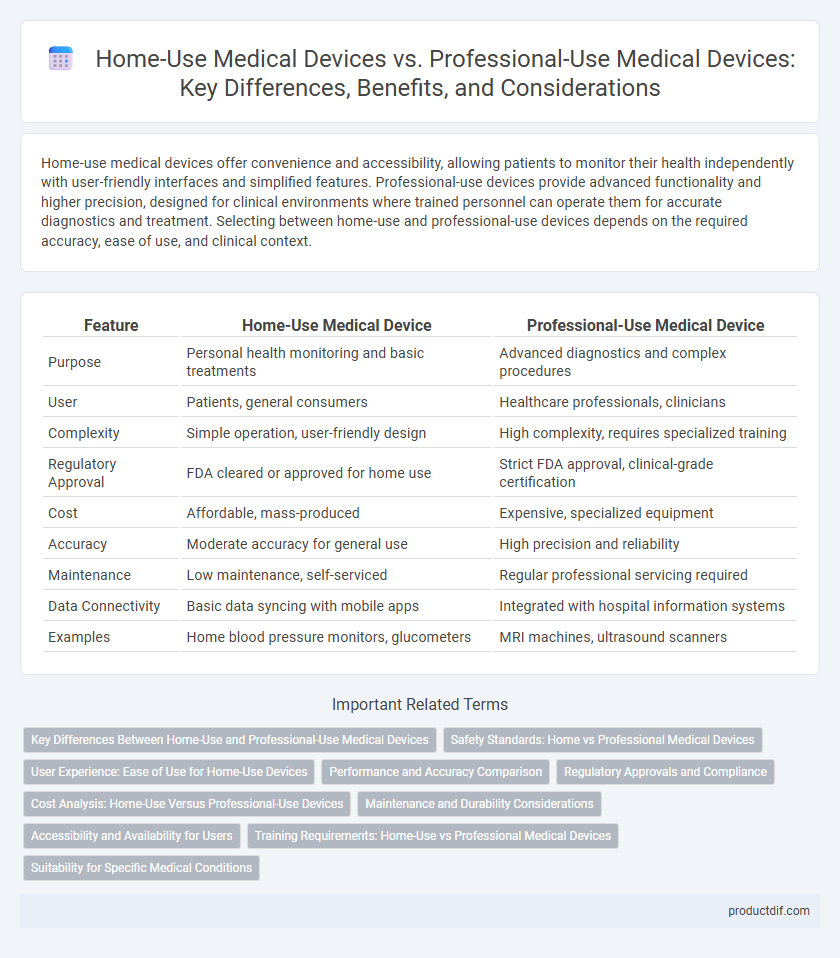Home-use medical devices offer convenience and accessibility, allowing patients to monitor their health independently with user-friendly interfaces and simplified features. Professional-use devices provide advanced functionality and higher precision, designed for clinical environments where trained personnel can operate them for accurate diagnostics and treatment. Selecting between home-use and professional-use devices depends on the required accuracy, ease of use, and clinical context.
Table of Comparison
| Feature | Home-Use Medical Device | Professional-Use Medical Device |
|---|---|---|
| Purpose | Personal health monitoring and basic treatments | Advanced diagnostics and complex procedures |
| User | Patients, general consumers | Healthcare professionals, clinicians |
| Complexity | Simple operation, user-friendly design | High complexity, requires specialized training |
| Regulatory Approval | FDA cleared or approved for home use | Strict FDA approval, clinical-grade certification |
| Cost | Affordable, mass-produced | Expensive, specialized equipment |
| Accuracy | Moderate accuracy for general use | High precision and reliability |
| Maintenance | Low maintenance, self-serviced | Regular professional servicing required |
| Data Connectivity | Basic data syncing with mobile apps | Integrated with hospital information systems |
| Examples | Home blood pressure monitors, glucometers | MRI machines, ultrasound scanners |
Key Differences Between Home-Use and Professional-Use Medical Devices
Home-use medical devices are designed for ease of operation, portability, and safety, allowing patients to self-monitor or manage conditions outside clinical settings, such as blood glucose meters and digital thermometers. Professional-use devices typically offer higher accuracy, advanced features, and regulatory compliance for clinical environments, including MRI machines and ultrasound systems. The primary differences lie in user interface complexity, accuracy requirements, and regulatory standards, with professional devices undergoing more rigorous testing and maintenance protocols.
Safety Standards: Home vs Professional Medical Devices
Home-use medical devices adhere to stringent safety standards tailored for non-professional environments, emphasizing ease of use, error prevention, and robust fail-safe mechanisms to protect untrained users. Professional-use devices meet higher regulatory requirements for accuracy, durability, and advanced features designed for healthcare providers operating under controlled clinical conditions. Both categories comply with international standards such as IEC 60601, but home devices prioritize user-friendly interfaces and risk mitigation strategies to ensure safe operation outside clinical settings.
User Experience: Ease of Use for Home-Use Devices
Home-use medical devices are designed with intuitive interfaces and simplified controls to enhance user experience for non-professionals, minimizing the need for extensive training. Ergonomic design considerations and clear instructions improve ease of use, reducing user errors and increasing compliance with treatment protocols. In contrast, professional-use devices often incorporate complex features intended for trained healthcare providers, which may complicate operation for untrained users.
Performance and Accuracy Comparison
Home-use medical devices prioritize user-friendly interfaces and safety features but often exhibit lower performance and accuracy compared to professional-use devices, which are calibrated for precise measurements under clinical conditions. Professional-use devices incorporate advanced sensors and rigorous quality controls to ensure reliable data critical for diagnosis and treatment. Accuracy discrepancies between the two categories can impact clinical decision-making, emphasizing the importance of selecting devices based on intended application.
Regulatory Approvals and Compliance
Home-use medical devices typically require approvals such as FDA 510(k) clearance or CE marking, emphasizing user safety, ease of use, and lower risk classification. Professional-use devices often undergo more rigorous regulatory pathways, including premarket approval (PMA) for higher-risk classifications, with compliance to stringent ISO 13485 standards and clinical trial evidence. Regulatory authorities prioritize risk assessment and post-market surveillance differently based on intended use, ensuring both categories meet appropriate safety and efficacy benchmarks.
Cost Analysis: Home-Use Versus Professional-Use Devices
Home-use medical devices typically have lower upfront costs and reduced ongoing expenses compared to professional-use devices, making them more accessible for individual patients. Professional-use devices involve higher acquisition, maintenance, and calibration costs due to advanced functionalities and regulatory compliance requirements. Cost analysis reveals that while home-use devices offer economic advantages for routine monitoring, professional-use devices provide superior accuracy and reliability essential for clinical decision-making.
Maintenance and Durability Considerations
Home-use medical devices typically require simplified maintenance routines and durable components designed to withstand frequent handling by non-experts, ensuring safety and reliability over time. Professional-use devices incorporate advanced maintenance protocols, including regular calibration and servicing by trained technicians to maintain precision and performance in clinical settings. Durability standards for professional devices are generally higher, supporting extensive use and stringent regulatory compliance, whereas home-use devices prioritize user-friendly durability features suited for personal care environments.
Accessibility and Availability for Users
Home-use medical devices offer increased accessibility and convenience by enabling patients to monitor and manage their health independently, reducing the need for frequent clinical visits. Professional-use devices, while often more advanced and accurate, require trained personnel and clinical environments, limiting their availability to users outside healthcare settings. The growing availability of FDA-approved home-use devices enhances patient empowerment, particularly in remote or underserved areas.
Training Requirements: Home-Use vs Professional Medical Devices
Home-use medical devices require minimal training designed for patients or caregivers, emphasizing user-friendly interfaces and clear instructions to ensure safe operation. Professional-use devices demand comprehensive training and certification for healthcare providers due to their complexity and the need for precise handling. Regulatory standards like FDA and CE mandates often dictate the extent of training necessary for each device category to minimize risks and optimize patient outcomes.
Suitability for Specific Medical Conditions
Home-use medical devices are designed for ease of operation and safety, making them suitable for managing chronic conditions like hypertension or diabetes in non-clinical settings. Professional-use devices offer advanced features and higher accuracy required for diagnosing complex conditions such as cardiovascular diseases or neurological disorders. Selecting between home-use and professional-use devices depends on the severity and specificity of the medical condition, as well as the need for clinical oversight.
Home-use device vs Professional-use device Infographic

 productdif.com
productdif.com